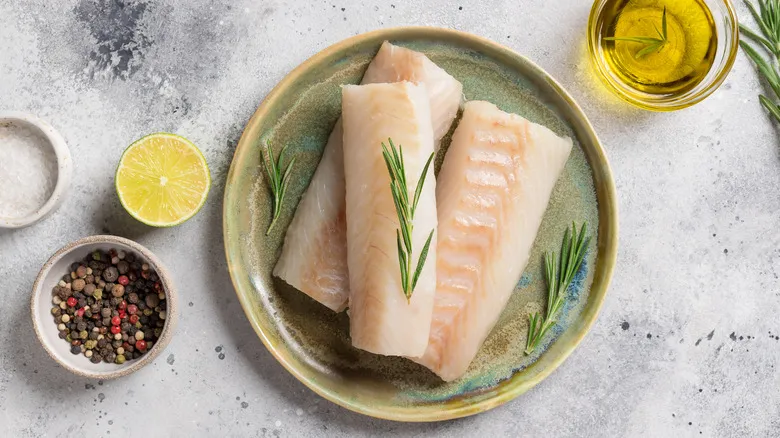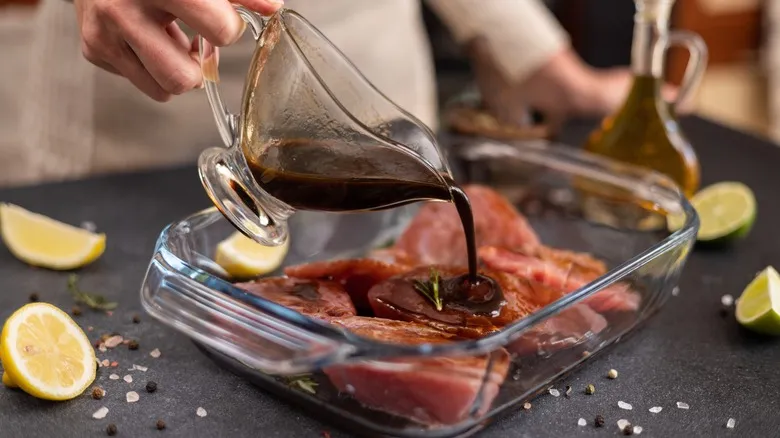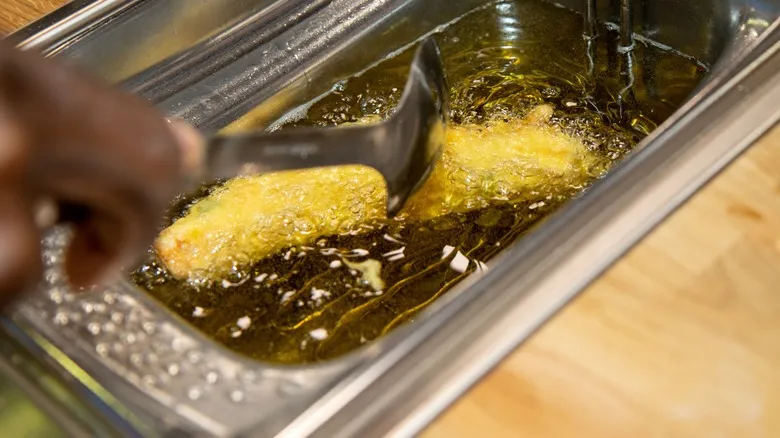Restaurants know that the type of fish you use matters

Experts agree that one of the most common errors home cooks make when preparing fish sandwiches is selecting the wrong type of fish. If you choose a fish that is too delicate, it may disintegrate in the pan or fryer. On the other hand, while heartier fish tend to hold their shape better, opting for something overly dense can result in a tough sandwich. Additionally, a strong fishy flavor can overshadow the other ingredients. Many chefs recommend using firm white fish for fried fillet sandwiches.
Gordon Drysdale, culinary director at Scoma's, emphasizes that mild white fish are ideal for fish sandwiches. "At Scoma's, we use fresh flounder from the Gulf, but any local rock cod is excellent for home cooks—especially ling cod, if available. That fish thrives in the fryer! These varieties all possess a juiciness that makes them perfect for sandwiches." Besides being juicy, cod offers a delightful buttery flavor and is tender yet sturdy enough to withstand frying. Other suitable options for fish sandwiches include haddock, halibut, and mahi-mahi.
Top-notch restaurants don't use frozen fish

One significant benefit that restaurants have over home cooks is their access to the freshest seafood available. While frozen fish may be more affordable and easier to find, most chefs will agree that fresh fish greatly enhances the texture and flavor of a fish sandwich. In fact, many consider opting for anything other than fresh fish to be one of the biggest errors consumers make when purchasing seafood. The quality of the fish is crucial as well.
Rena Awada, owner and head chef at Healthy Fitness Meals, emphasizes the importance of using fresh, high-quality fish sourced from a market or grocery store. Look for fish that appears clean, bright, and shiny. If it has a strong fishy odor, it’s likely not fresh. Additionally, don’t hesitate to inquire about when the fish was caught and its origin. "Ultimately, attention to detail and the use of quality ingredients are essential elements that set restaurant fish sandwiches apart from those made at home," Awada states.
Marinating the fish can take it to the next level

If you've ever been curious about how restaurants achieve juicy and flavorful fish sandwiches, Joe Bowab, CEO and founder of Lobster Anywhere, has some valuable tips. "Be sure to marinate your fish before cooking to boost its flavor and tenderness," Bowab advises. White fish is often quite mild, which can make it a bit bland. A marinade that includes ingredients like oil, juice, herbs, and spices can add a burst of flavor.
The options for fish marinades are virtually limitless. For a fresh twist, consider using olive oil, lemon, and herbs. If you're looking for a tropical vibe, try coconut oil, lime juice, and chili. Rena Awada recommends a combination of soy sauce, honey, and garlic for salmon sandwiches.
However, it's important to keep in mind that acidic ingredients can alter the texture of the fish. Acids break down the proteins in the meat through a process known as denaturation. Therefore, it's best not to marinate your fish for too long, as this common error can result in a mushy texture. A good guideline for fish sandwiches is to marinate the fish for just 15 to 30 minutes before cooking.
Chefs match the type of fish to the batter

Although the fish is the highlight of a fish sandwich, chefs understand that the batter plays a crucial role as well. "The primary reason a fish sandwich tastes better in a restaurant than at home is that we pair the fish with the right batter," explained Chef Larry Kearns of Dahlia's Restaurant & Porch. When selecting a batter, it's important to consider the fish's texture. Firmer, thicker fish do well with light, airy batters, while flakier varieties benefit from a coarser breading that helps protect them.
For slightly firm white fish like cod or halibut fillets, a beer batter is perfect, providing a light crunch without overwhelming the fish's flavor or texture. Flakier fish such as whiting pair nicely with a coarser crust that adds texture to their softness. Kearns recommends using a batter that includes cornstarch and cornmeal for whiting. Additionally, panko breadcrumbs can offer an extra crunch and bite that a smooth beer batter typically lacks.
The batter used at restaurants is always seasoned

No matter which batter you opt for your fish, nearly every expert we consulted emphasized that seasoning is the key to an exceptional fish sandwich. "In restaurants, we typically use a unique blend of seasonings in our batter or breadcrumbs that enhances the fish's flavor without overwhelming it," explained Nic Vanderbeeken, executive chef at Apéritif. Some chefs simply season the batter and breading with salt and pepper, while others incorporate hints of paprika or garlic powder. The essential trick is to maintain a balance so that the fish's flavor remains prominent.
Gordon Drysdale also highlighted that the placement of seasoning can impact the outcome. For instance, he coats his fish in flour, dips it in egg, and then covers it with panko breadcrumbs. However, he chooses to season the beaten eggs rather than the dry components. "By seasoning the egg instead of the flour or breadcrumbs, you ensure that the seasoning is evenly distributed (otherwise, the salt may settle at the bottom of the flour or crumbs and become ineffective)," he noted.
Using the right equipment can make a huge difference

Restaurants not only benefit from high-quality ingredients but also boast state-of-the-art equipment. For instance, many establishments utilize deep fryers that produce fish with a beautiful golden, crispy crust. Additionally, chefs rely on fillet knives for precise fish portioning and fryer thermometers to ensure the oil is at the right temperature. They might even use specialized kitchen tools you may not be familiar with, such as a fish turner, herb stripper, or fish spatula. So, how can you keep up?
Kevin Ashton, a culinary advisor at Restaurantji, emphasizes that there are two essential tools home cooks need to make restaurant-quality fish sandwiches: a reliable pan and a thermometer. "A non-stick pan or cast-iron skillet guarantees even cooking and provides an excellent sear for crispy fish. A deep-fry thermometer is crucial for maintaining the perfect temperature until you achieve that crispy golden finish," he explains. Beyond these essentials, you don't need anything overly elaborate to whip up a fantastic fish sandwich, although a deep fryer can certainly be beneficial.
Getting the temperature of the oil right is crucial for crisp

There's nothing more disappointing than sinking your teeth into a fish sandwich only to encounter a mouthful of mush. Crispiness is a key element that elevates fish sandwiches to greatness. If you're struggling to achieve that satisfying crunch, the temperature of your oil might be the culprit. "I would suspect that a fryer that isn't hot enough has ruined many homemade sandwiches," said Gordon Drysdale. "The goal is to get the heat just right so that the coating is crispy while the fish is fully cooked."
Ideally, your oil should be heated to between 350 and 375°F to ensure the fish cooks thoroughly and develops a beautiful crust. This is where an oil thermometer proves useful. Don’t have one? You can use Rachael Ray's method: dip the handle of a wooden spoon into the oil; if bubbles form around it, your oil is likely hot enough. Remember not to overcrowd the pan, as this can hinder the fish from becoming crispy. If you're frying in batches, allow the oil to return to the proper temperature between each round.
Overcooking the fish can result in disaster

While soggy fish is a common frustration for many home cooks, overcooked fish is equally problematic. "The primary error that home cooks should steer clear of is overcooking the fish. This results in a bland flavor and a very dry sandwich," explained Eric Sornoso, co-founder of Mealfan. A digital thermometer can be incredibly helpful in avoiding burnt fish. It allows you to monitor both the oil temperature and the internal temperature of the fish, which should reach about 145°F.
Chefs also understand that the type of oil used is crucial. Different oils have distinct smoke points, which can affect the cooking process. Canola oil and vegetable oil are ideal for deep frying fish due to their high smoke points, allowing them to reach temperatures between 375°F and 450°F without burning or smoking. This ensures your fish achieves the desired crunch while remaining moist inside. It's best to avoid using butter, extra virgin olive oil, and coconut oil, as these fats have lower smoke points and can impart a bitter, burnt flavor to your fish.
Chefs often rest the fish before assembling the sandwich

Once your fish is perfectly fried and crispy, the first thing you might want to do is place it on a bun with some sauce and enjoy it while it's still hot. However, many chefs prefer to let their fish rest before putting together the sandwich. There are several reasons for this. First, resting helps the heat distribute evenly throughout the meat. It can also prevent your sandwich from becoming soggy and allows the flavors to blend for a more satisfying bite.
There is some discussion about the best method for draining fried foods. Some argue that a wire rack is the ideal choice because it allows steam to escape and air to circulate around the fried items. Others believe that using a plate or bowl lined with paper towels is better, as the towels absorb excess oil that could otherwise seep into the food. You can also place your fried fish on a wire rack and keep it warm in the oven, just be sure to set the temperature low to avoid overcooking and drying it out.
The right type of bread is also a key factor

Since bread serves as the vessel for a fish sandwich, it's an aspect that chefs pay close attention to. "A great sandwich begins with the right base, and a toasted brioche or ciabatta can truly elevate the experience. The contrast in heat and texture between the crispy fish and the soft, slightly warm bun is essential for achieving a restaurant-quality sandwich," says Nic Vanderbeeken.
Ideally, your buns should be soft and pillowy, yet sturdy enough to hold all the components together. It's important that the bread enhances the crispy fish rather than overpowering it. Hard, crusty breads can be problematic, as they may make the sandwich too dense and challenging to eat. On the other hand, slices of white sandwich bread can become soggy and disintegrate under the weight of the fish and toppings. Opt for soft breads with some substance, such as brioche, potato rolls, or Kaiser rolls. Hamburger buns can also be a good choice, as long as they are large enough to accommodate the fish.
Professional cooks know exactly how and where to toast the bun

One key element that distinguishes restaurant fish sandwiches from many homemade versions is the preparation of the bun. "Never skip buttering or toasting the bun, as it can become soggy. A well-prepared bun is essential for adding texture and flavor to your sandwich," advised Kevin Ashton. Butter not only enhances richness and flavor but also acts as a barrier against moist toppings. Toasting the bun helps prevent excessive moisture and provides structure to the sandwich.
Many chefs believe that mastering the buttering and toasting process is an art form. Gordon Drysdale suggests buttering only the inside of the bread before griddling it. While you could toast the entire bun, this may lead to it becoming too hard and dry. Applying butter to both sides is a definite mistake, as it can saturate the bread and make it greasy. Additionally, too much butter can overpower the flavors of the fish and toppings. Keep in mind that the ideal fish sandwich is all about achieving balance.
A sandwich press is a well-kept restaurant secret

Who says sandwich presses are only for paninis? Chefs understand that this versatile kitchen gadget has a variety of applications, including creating amazing fish sandwiches. "Using a panini press can give your sandwich a delightful crispy exterior. It also helps to lightly toast the bread and melt any cheese or toppings inside," Rena Awada shared with Chowhound. She noted that it also simplifies the process of cooking fish evenly while keeping it compact.
If you prefer grilled fish over deep-fried fillets, you might even consider cooking your fish in a panini press. Just season your fish, lightly oil the grates, place the fish in the press, and you can enjoy tasty fish in just minutes. This technique can save you time and eliminate the hassle of dealing with extremely hot oil and the mess that often accompanies it. However, it's worth mentioning that you may miss out on the crunch that many people love in a traditional fish sandwich.
Sauces and condiments take restaurant fish sandwiches to the next level

What toppings do you like to put on your fish sandwiches? If you're similar to many home cooks, you might stick to the classics like mayonnaise, lettuce, and perhaps a slice of cheese. However, if you ask professional chefs about their favorite condiments, you'll likely receive a diverse range of responses. This is because chefs understand that unique flavor and texture combinations can elevate a fish sandwich to new heights.
Some of the distinctive toppings recommended by the experts we consulted include flavorful sauces such as freshly prepared tartar sauce, zesty remoulade, and spicy aioli. Adding pickled vegetables, mango salsa, fried capers, and fennel slaw can introduce crunch, flavor, and vibrant color. Many chefs also use citrus to counterbalance the richness of fried fish or incorporate fresh herbs for a burst of brightness.
One important thing to remember when choosing toppings is to avoid overwhelming the fish's flavor. As Rena Awada wisely noted, "While a sandwich is often celebrated for its layers of ingredients, it's crucial to allow the fish to take center stage. Feel free to experiment with various toppings and sauces, but keep the balance in mind."
Recommended

Ina Garten's Secret Ingredient Mayonnaise For Flavor-Bomb Tuna Melts

Swap Your Midnight Grilled Cheese For A Grilled PB&J Sandwich

The 3 Fish Fillet Cuts You Need To Know About

5 Ways You Can Use The Leftover Oil From Canned Tuna
Next up

